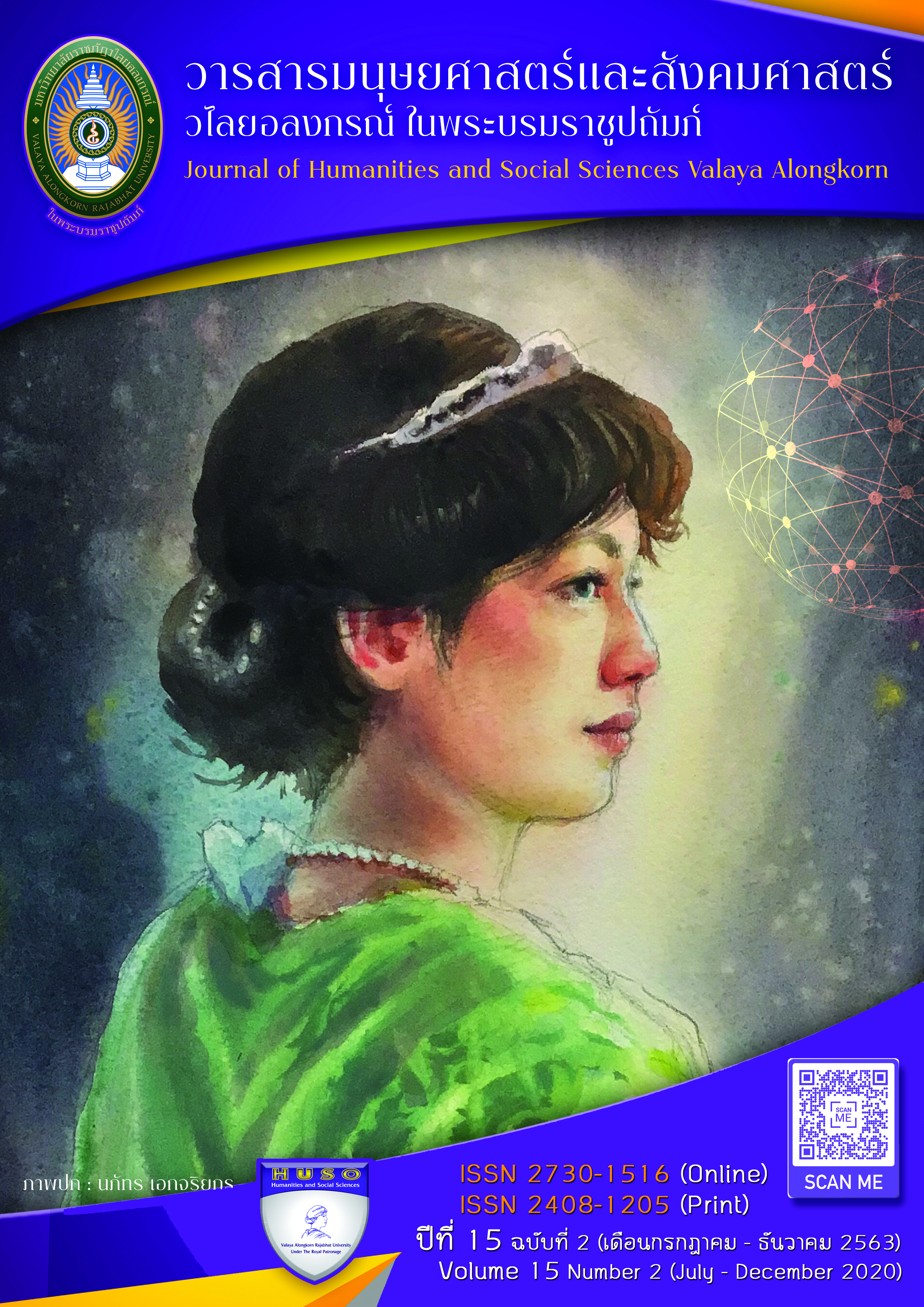ความสัมพันธ์ระหว่างความสามารถในการเผชิญและฟันฝ่าอุปสรรค ความฉลาดทางอารมณ์ และความพึงพอใจในงานของนักธุรกิจเครือข่ายบริษัทการตลาดเครือข่ายแห่งหนึ่ง โดยมีพันธสัญญากับเป้าหมายเป็นตัวแปรสื่อ
Main Article Content
บทคัดย่อ
การวิจัยนี้มีวัตถุประสงค์เพื่อศึกษาความสัมพันธ์ระหว่างความสามารถในการเผชิญและฟันฝ่าอุปสรรคและความฉลาดทางอารมณ์ ความพึงพอใจในงาน โดยมีพันธสัญญากับเป้าหมายเป็นตัวแปรสื่อ เครื่องมือที่ใช้ในการวิจัยประกอบด้วย แบบสอบความสามารถในการเผชิญและฟันฝ่าอุปสรรคความฉลาดทางอารมณ์ ความพึงพอใจในงาน และพันธสัญญากับเป้าหมาย สถิติที่ใช้ในการวิเคราะห์ข้อมูลคือการวิเคราะห์สหสัมพันธ์แบบเพียร์สัน การวิเคราะห์การถดถอย และสถิติของโซเบล ผลการวิจัยพบว่าความสามารถในการเผชิญและฟันฝ่าอุปสรรคและองค์ประกอบย่อยมีความสัมพันธ์ทางบวกกับความพึงพอใจในงาน (r = .368, r = .183, r = .306, r = .143, และ r = .378 ตามลำดับ) ความฉลาดทางอารมณ์ทางบวกกับความพึงพอใจในงาน (r = .377, r = .317, r = .406, และ r = .368 ตามลำดับ) และพันธสัญญากับเป้าหมายมีความสัมพันธ์ทางบวกกับความพึงพอใจในงานมีความสัมพันธ์ทางบวกกับความพึงพอใจในงาน (r = .434) และพบว่าพันธสัญญากับเป้าหมายเป็นตัวแปรสื่อบางส่วนระหว่างความสามารถในการเผชิญและฟันฝ่าอุปสรรคกับความพึงพอใจในงาน (Z = 3.806) และพันธสัญญากับเป้าหมายเป็นตัวแปรสื่อสมบูรณ์ระหว่างความฉลาดทางอารมณ์กับความพึงพอใจในงาน (Z =
4.567)
Article Details
ลิขสิทธิ์บทความวิจัยที่ได้รับการตีพิมพ์เผยแพร่ในวารสารมนุษยศาสตร์และสังคมศาสตร์ วไลยอลงกรณ์ ในพระบรมราชูปถัมภ์ ถือเป็นกรรมสิทธิ์ของคณะมนุษยศาสตร์และสังคมศาสตร์ มหาวิทยาลัยราชภัฏวไลยอลงกรณ์ ในพระบรมราชูปถัมภ์ ห้ามนำข้อความทั้งหมดหรือบางส่วนไปพิมพ์ซ้ำ เว้นแต่จะได้รับอนุญาตจากมหาวิทยาลัยเป็นลายลักษณ์อักษร
ความรับผิดชอบ เนื้อหาต้นฉบับที่ปรากฏในวารสารมนุษยศาสตร์และสังคมศาสตร์ วไลยอลงกรณ์ ในพระบรมราชูปถัมภ์ เป็นความรับผิดชอบของผู้นิพนธ์บทความหรือผู้เขียนเอง ทั้งนี้ไม่รวมความผิดพลาดอันเกิดจากเทคนิคการพิมพ์
References
วรัญญพร ปานเสน. (2550). ความสามารถในการเผชิญและฟันฝ่าอุปสรรค ความผูกพันใจต่อเป้าหมายและวิธีการสร้างอิทธิพลที่ส่งผลต่อการปฏิบัติงานของนักธุรกิจอิสระในธุรกิจขายตรงหลายชั้น. มหาวิทยาลัยธรรมศาสตร์.
อัมพิกา สุนทรภักดี. (2559). การรับรู้การสนับสนุนจากองค์การ การรับรู้ความสามารถของตนเองด้านอาชีพ และผลการปฏิบัติงานของพนักงานขายในธุรกิจประเภทอาหารและเครื่องดื่มแห่งหนึ่ง โดยมีการยึดมั่นกับเป้าหมายเป็นตัวแปรสื่อ. การศึกษาตามหลักสูตรศิลปศาสตรมหาบัณฑิต. กรุงเทพ : มหาวิทยาลัยธรรมศาสตร์.
Bipp, T. and Kleingeld, A. (2011), "Goal‐setting in practice: The effects of personality and perceptions of the goal‐setting process on job satisfaction and goal commitment , Personnel Review, 40 (3), 306-323.
Brayfield, A. H., & Rothe, H. F. (1951). An index of job satisfaction. Journal of Applied Psychology, 35, 307–311.
Goleman, Daniel. (1998). Working with emotional intelligence. Bantam.
Hoppock, R. (1935). Job satisfaction. New York: Harper and Brothers.
Lee, H. J. (2018). How emotional intelligence relates to job satisfaction and burnout in public service jobs. International Review of Administrative Sciences, 84 (4), 729-745.
Lee, J. J., & Ok, C. (2012). Reducing burnout and enhancing job satisfaction: Critical role of hotel employees’ emotional intelligence and emotional labor. International Journal of
Hospitality Management, 31 (4), 1101-1112.
Locke, E. A., & Latham, G. P. (1990). A theory of Goal setting and Task Performance. Prentice- Hall, Inc.
Locke, E. A., Latham, G. P., & Erez, M. (1988). The determinants of goal commitment. Academy of Management Review, 1, 23–39.
Locke, E. A., Shaw, K. R, Saari, L. M., & Latham, G. P. (1981). Goal setting and task performance: 1968-1980. Psychological Bulletin, 90, 125-152.
Locke, L. A., & Latham, G. P. (2002). Building a practically useful theory of goal setting and task motivation. American Psychologist, 57 (9), 705-717.
Rakesh Kumar (2016). The Relationship of Personal Characteristics and Job Satisfaction to Adversity Quotient of Police Officers in Shimla District of Himachal Pradesh. International Journal of Economics and Management Sciences, 5 (3), 331-338.
Salovey P & Mayer. J.D. (1990). Emotional intelligence, Imagination, cognition and Personality. New York: Basic Books.
Shooshtarian, Z., Ameli, F., & Amini Lari, M. (2013). The effect of labor emotional intelligence on their job satisfaction, job performance and commitment. Iranian Journal of Management Studies, 6 (1), 27-43.
Sobel, M. E. (1982). Asymptotic intervals for indirect effects in structural equations models. In S. Leinhart (Ed.), Sociological methodology. San Francisco: Jossey-Bass.
Song, J. H., & Woo, H. Y. (2015). A study on AQ (Adversity Quotient), job satisfaction and turnover Intention according to work units of clinical nursing staffs in Korea. Indian Journal of Science and Technology, 8 (8), 74-78.
Stoltz, P.G. (1997). Adversity Quotient: Turning Obstacles into Opportunities. New York: Wiley & Sons, Inc.
Yamane, T. (1973). Statistics an Introductory Analysis. Tokyo: John Weatherhill, Inc.

